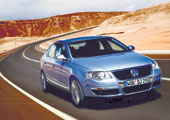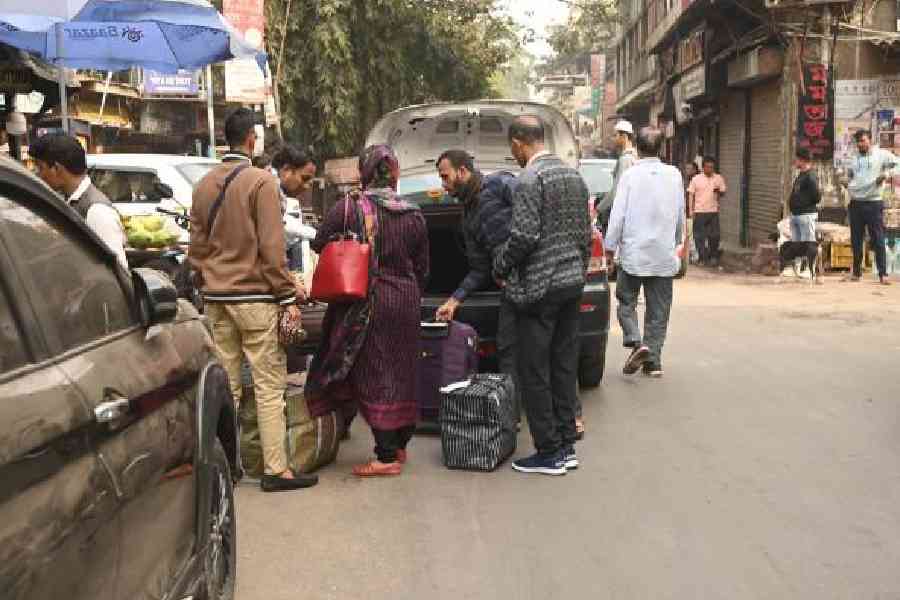 |
 |
 |
| (From top): The Passat; the Phaeton; the Toureg SUV |
It’s quite a thrill to get behind the wheel of a brand new car and let it rip on the road. It’s an even bigger rush when you get a chance to do that thrice over in three new models ? and that too of German origin. Yup, I was one lucky guy indeed, as recently I had the opportunity of test-driving three new Volkswagens. Ahead of VW’s arrival in India, Kashyap Vehicle Works has set up a dealership outside New Delhi from where it will be selling cars imported into India. Three cars are here already ? the Phaeton, the Touareg SUV and the Passat. It looks like the D Segment is going to be well and truly shaken up ? Skoda, Audi, Mercedes and BMW better watch out.
Translated, the words ‘Volks’and ‘Wagen’ read ‘peoples’ car’. Yet, the Phaeton is the very reverse of that. It’s huge, both internally and externally. Volkswagen is going up against the likes of the Audi A8, the Mercedes S Class as well as the BMW 7 Series. That’s a tall order indeed. But have a look at what the Phaeton has to offer. The top-of-the-line version has either a six-litre W12 petrol engine or a five-litre V10 diesel unit powering it. But take it from me; you don’t want to drive a Phaeton. No, sir! Volkswagen believes that the Phaeton is its version of unadulterated luxury and to experience that to the fullest, one must take a back seat. And what a back seat it is too!
Prepare to be surrounded by features like four-zone air-conditioning with individually adjustable controls, Eucalyptus wood d?cor on the upper door trim strips as well as at the top of the centre console, the front cup holders and on the instrument panel. Relax to music from the high-end 12/12 audio system ? that’s a 12-channel amplifier powering 12 speakers via a digital signal processor. Be oblivious to bumps courtesy the self-levelling air suspension with continuous, speed-dependent electronic damping control. Pretty impressive!
The Phaeton I drove was a five-seater long wheelbase version with a 3.2-litre V6 engine developing around 240bhp. Propelling it along the road were four huge 255/45 R 18 tyres fitted to 8 1/2J alloy wheels. While I had a multi-function steering wheel to command my ship, the centre console on my left would not have looked out of place in a modern aircraft. My biggest concern was manoeuvring the behemoth on what seemed to be an impossibly narrow road. But as the Phaeton gulped down the miles, it became easier to drive. Of course, the auto-box and power steering go a long way in making things easy for the driver. But don’t forget this is not a driver’s car but a luxury vehicle. Yet somehow, the VW badge and luxury don’t seem to go together.
The Touareg was up next. This SUV shares its platform with the Porsche Cayenne. However while the Cayenne is petrol-engined, the Touareg plays on a different strength, having a a diesel engine. What the Touareg does share with the Cayenne is the undercarriage and the 4x4 system though the split is different. The pricing ? circa Rs 40 lakh and upwards will ensure that very few, if any at all of the models sold in India will be seen hitting the dirt road.
The Cayenne is designed more for driving on a road than off it while the Touareg’s functions are a 50-50 split, for both on and off-road driving. Touaregs come with six-speed gearboxes, automatic transmissions and permanent 4XMOTION four-wheel drive. However, if the conditions warrant it, then up to 100 per cent of the driving torque can be fed to one of the two axles. The interior is quite roomy, good for five passengers to travel with 555 litres volume of luggage.
The car I drove briefly had a V6 diesel. The engine, developing a max power of 140bhp, revs cleanly and the acceleration is good. The wheels were 8J X 18 alloys fitted with 255/55 R 18 tyres. I wanted to see what it could really do and throw it around a bit, but the price tag proved to be a deterrent. Besides, there really is no point in testing an off-roader on a tarmac road ? it tells you nothing except perhaps that the SUV wallows over the undulations of the surface. The Touareg should sell well as it is a diesel. It feels a little cramped inside but maybe that’s because of the all-black interior. The Touareg is packed with features like the Climatronic double AC system with 4-zone temperature regulation.
But I’ve saved the best for last ? the Passat. The first generation Passat made its first appearance way back in 1973. The car I drove was introduced in March 2005 and is based on a new platform, the B6. That makes it a generation ahead of the Skoda Superb, which is based on the previous (stretched) Passat platform. The new Passat is longer, wider and taller than its predecessor and the boot volume is more too. The good news is that with ES, six airbags and other safety devices; the car earned a five-star rating in the Euro-NCAP tests.
While the Touareg and the Phaeton are CBU imports, the new Passat is going to be homologated so that the price will be low enough to slot it in between the C Class and E Class Mercs. As costs are high, Kashyap Vehicle Works is homologating just one model ? a Passat B6 Sedan High Line with a 2.0 TDI engine, and a six-speed DSG automatic gearbox with dual clutch, which is what I drove.
The gearbox has two settings, D and S. Keep it in D and the Passat behaves like a better-appointed diesel vehicle, just the ticket for everyday runs to office and back. Ideal for the executive but boring! However stick the lever in S, step on the pedal and the Passat takes on a whole new character, just like a schizophrenic. Suddenly, all the 140 horses come alive. This version of the Passat has a rated top speed of 209kph, and the 320Nm of torque available at just 1800rpm means that it is quite easy to force wheelspin. With that sort of performance, who cares that the rear seat only has passive AC vents and not independent temperature controls? Actually, who cares about the rear seat?
It’s quite evident that the Passat is going to be VW’s sales leader. But the question is, how will one Delhi-based importer-cum-dealer service the nation? Channel partners are what Kashyap Vehicles is banking on ? all one needs to do is go to a Skoda dealership and get the car serviced. A Skoda dealer will be able to order parts too.
Volkswagen is testing the waters via Kashyap. Unlike Skoda that had to build itself up from scratch in India, VW is a well-known name. And ultimately, that should stand it in good stead.
My first car
 |
Abhishek Dutta
fashion designer
My very first car was a Maruti Zen, which I bought in 2001. Unfortunately, it got stolen within one-and-a-half months. I’d parked it at Ballygunge Phari at around five in the evening and 10 minutes later when I returned, it had vanished. I never found it again. Luckily I managed to retrieve the insurance money on it, never mind that it was several months later.
My second car ? a Maruti Wagon R ? then was more like my first car. And even though I’ve just bought a Honda City, I still have my Wagon R, as it’s been lucky for me. Also, it’s hassle-free and has never really given me any trouble on the road. What I like most is that even though it’s a small car (which is essential in a city like Calcutta) it’s got ample leg and head room, and it handles potholes well too.
My car is painted bright canary yellow and I’ve added personal touches to it like customised stickers and leather seats, and neon lights beneath the car.










